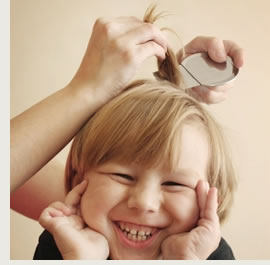|
|
||||
|
||||
| Nits | ||||
| The four-letter word every mum dreads | ||||
 It's Spring and the warmer temperatures generally means we're coming into nit season. Are you itching already?. No? Well, read on. It's Spring and the warmer temperatures generally means we're coming into nit season. Are you itching already?. No? Well, read on.Head lice, commonly known as "nits" in Australia or the UK or "cooties" if you're in the USA are the most incredibly frustrating and annoying little insects which will, at some point, be the bane of every mother's life. The head louse is a tiny greyish-brown insect, about 2.5mm long. These little critters cling onto hair and are usually found in the scalp. They live on the blood of their generous host - your child. The female lays eggs that are attached to hair, close to the scalp and can be very difficult to remove. The baby louse hatches after about a week and leaves a little white eggshell on the hair, which is called a "nit". No matter how clean your child's hair, he or she will not escape lice. In fact the greasier and dirtier a child's hair, the more likely they are to avoid lice, because the female lice find it hard to grip to the hair to lay eggs. Some schools and child care services often advise not washing your child's hair for the first week of attending to minimise risk. We aren't really sure if this works, but of course most small children love the excuse to remain dirty. So how are they transferred? Well by any close contact. Cuddling, huddling, reading close to each other, whispering etc etc. That louse will not miss an opportunity. Lice are flightless and can only jump a short way, but when your children are always in close contact, it's not very hard to make that leap! You won't necessarily know straight away. Bites from head lice can cause intense itching and irritation on the scalp, but these symptoms may not appear until at least two months after the lice first arrive. Are you itching now?! The only truly effective way to find lice is to use a nit-comb. You can get these from any pharmacy. The best thing is to wash your child's hair and then put in conditioner. Don't rinse. Comb through with a normal comb to get out the tangles and then start with the nit comb in small sections of the hair. Comb right from the very base at the scalp to the ends. Lice will be on the scalp, so make sure you get as near to it as possible to pick them up. It can take a while, but it's not nearly as awful as people make out. Do this in the bathroom with a full basin of water. After every run through with the comb, tap the comb into the water. If there are lice, you'll soon see them. They can be quite tiny, but if you train your eye you'll spot tiny little brown/grey and almost transparent critters in the water. Of course you can't see the eggs like this, but if there are lice, there will be eggs. There is no miracle cure and they are hardy little buggers that will resist as long as possible! You can buy chemical and natural Lice shampoos and prevention sprays in pharmacies, but every doctor will tell you that no matter what you put on the hair to kill the lice, by far the most important part of de-lousing is an extremely thorough comb-through. Really you can just use conditioner and a comb without any lotions and potions. One good natural killer is tea tree oil or eucalyptus oil. Just buy a bottle from the supermarket or health food store.
For more on child care and head lice - read our article |
|
|||||||||
